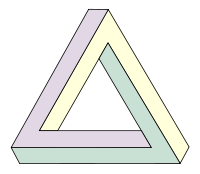Difference between revisions of "Penrose triangle" - New World Encyclopedia
(Started) |
|||
| Line 1: | Line 1: | ||
| − | {{Claimed}} | + | {{Claimed}}{{Started}} |
[[Category:Politics and social sciences]] | [[Category:Politics and social sciences]] | ||
[[Category:Psychology]] | [[Category:Psychology]] | ||
Revision as of 16:42, 14 September 2007

The Penrose triangle, also known as the tribar, is an impossible object. It was first created by the Swedish artist Oscar Reutersvärd in 1934. The mathematician Roger Penrose independently devised and popularised it in the 1950s, describing it as "impossibility in its purest form." It is featured prominently in the works of artist M.C. Escher, whose earlier depictions of impossible objects partly inspired it.
The tribar appears to be a solid object, made of three straight beams of square cross-section which meet pairwise at right angles at the vertices of the triangle they form.
This combination of properties cannot be realized by any 3-dimensional object. Nevertheless, there do exist 3-dimensional solid shapes each of which, when viewed from a certain angle, has the appearance of possessing all the qualities mentioned in the above paragraph. That is, it appears the same as the purple, green, and yellow 2-dimensional depiction of the Penrose triangle on this page.
M.C. Escher's lithograph Waterfall depicts a watercourse that flows in a zigzag along the long sides of two elongated Penrose triangles, so that it ends up two stories higher than it began. The resulting waterfall, forming the short sides of both triangles, drives a water wheel. Escher helpfully points out that in order to keep the wheel turning some water must occasionally be added to compensate for evaporation.
The concept can be extended to other polygons, making, for example the "Penrose square," but the visual effect is not as striking.
There exists some terminological confusion over whether "Penrose triangle" refers to the 2-dimensional depiction of an impossible 3-dimensional object, or that impossible object itself. (Philosophically, it is unclear what "that impossible object" refers to, other than a set of conditions that cannot be satisfied.)
If a line is traced around the Penrose triangle, a 3-loop Möbius strip is formed.
Other Penrose polygons
While it is possible to construct a Penrose triangle with other regular polygons to create a Penrose polygon, the visual effect is not as striking, and as the sides increase, the image seems to be warped or twisted.
Penrose hexagon
External links
- Escher for Real constructions
- The impossible triangle made possible
- Three-dimensional model of a Penrose triangle for SketchUp
Credits
New World Encyclopedia writers and editors rewrote and completed the Wikipedia article in accordance with New World Encyclopedia standards. This article abides by terms of the Creative Commons CC-by-sa 3.0 License (CC-by-sa), which may be used and disseminated with proper attribution. Credit is due under the terms of this license that can reference both the New World Encyclopedia contributors and the selfless volunteer contributors of the Wikimedia Foundation. To cite this article click here for a list of acceptable citing formats.The history of earlier contributions by wikipedians is accessible to researchers here:
The history of this article since it was imported to New World Encyclopedia:
Note: Some restrictions may apply to use of individual images which are separately licensed.




